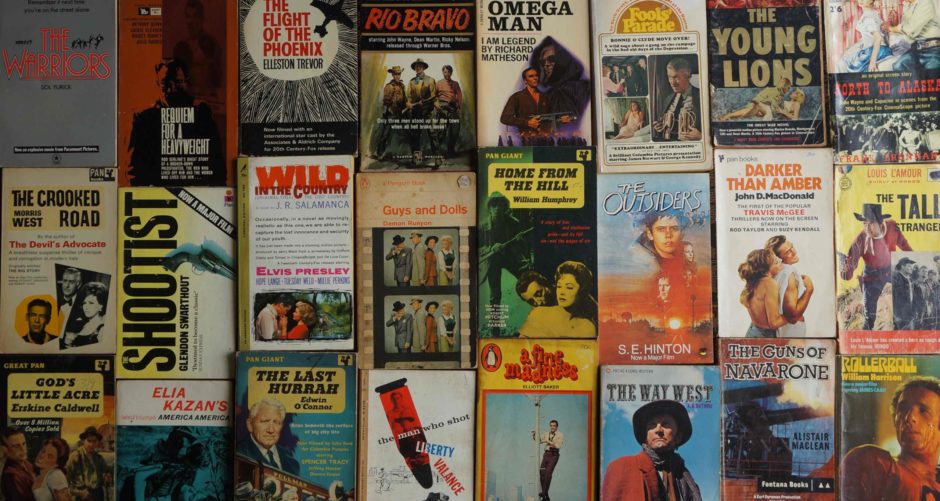FILM DIRECTOR: Blake Edwards
SCREENWRITER: George Axelrod
FILM STARS: Audrey Hepburn, George Peppard, Patricia Neal, Buddy Ebsen, Martin Balsam, Mickey Rooney, John McGiver, Miss Beverly Hills, Orangey the cat.
COUNTRY: USA
THIS BOOK
AUTHOR: Truman Capote
TYPE: Novella
PUBLISHER: Penguin
THIS EDITION PUBLISHED: 1961
COUNTRY: Great Britain
COVER: Paperback
THE ORIGINAL BOOK
ORIGINAL AUTHOR: As Above
YEAR FIRST PUBLISHED: 1958
ORIGINAL BOOK TITLE: The film title (the book was a book of unrelated short stories)
NOTES
GENRE: Romantic Comedy
WORDS: Capote’s melancholy novella is a masterpiece of short-ish fiction. In paragraphs he rounds out entire characters and gives life to months of events. You read a page and you come out feeling you have read a chapter, and it’s never tiresome.
A classic it is but it will always be overshadowed by the 1961 film, a masterpiece of the romantic comedy genre, with perfect direction by Blake Edwards, an iconic Audrey Hepburn, magnificent early 60s fashions and the memorable music of Henry Mancini. Blake Edwards could do no wrong (despite all his fame he is still quite undervalued) and George Axelrod’s screenplays always had bite (Bus Stop, The Manchurian Candidate, How to Murder Your Wife, Lord Love a Duck). The cast work perfectly, Hepburn became an even bigger icon and George Peppard’s career was established. Special mention to Orangey the cat, the only cat to win two PATSY Awards (Picture Animal Top Star of the Year, an animal actor’s version of an Oscar), the first for the title role in a favourite film of mine, Rhubarb (1951) (though he could have been one of several cats used in the film) and the second for his portrayal of “Cat” in Breakfast at Tiffany’s. And on top of it all Henry Mancini’s theme song (with lyrics by Johnny Mercer) “Moon River” which went to #1 in the easy Listening Charts. Many vocal versions were done, the most familiar one by Andy Williams who never released the song as a single, but his LP “Moon River and Other Great Movie Themes” was certified gold and went to #3 in the pop charts in 1962.
The book (a classic) is (sadly) almost superfluous to the film … it reads easily though, with the usual, astute, Capote observations. The novella is set in 1940s New York City, a place Capote knew well. Many people have been named or claim to be the inspiration to the central character Holly Golightly, but the character is probably a composite of a number of people Capote knew. Holly (in her late teens) is a New York café society girl who lives off wealthy men who take her to clubs, restaurants and the theatre, and give her money, jewellery and expensive gifts. According to Capote she is not a prostitute, but an “American geisha”. The film is lighter and more romantic than the book. though it does hint at or check all the “scandalous” elements in the book. There are, inevitably, some differences – the fairy-tale love in the film gets more teeth in the book where love is complicated, messy, and painful. The narrator in the book becomes Paul Varjak (played by George Peppard) and he is in some ways no different to Holly because he is a “kept man” taking money from older Mrs Emily Eustace Failenson played by Patricia Neal (the Failenson character doesn’t exist in the book and the narrator doesn’t have a female “benefactor”). Many assume the narrator is gay, because Capote was, but in the book, despite not having a girlfriend, that is not mentioned. The Mr. Yunioshi character played by Mickey Rooney is larger and more comedic in the film, the characters of Mag Wildwood and Rusty Trawler are more central in the book, the characters Joe Bell (a bartender) at a bar they regularly drink at, and Madame Sapphia Spanella (another tenant in the building) do not exist in the film, central symbols like the “birdcage” aren’t central in the film and even the cat finds a home with someone else rather than a return to Holly. Dramatic twists and turns, like Holly hearing of the death of her brother Fred, and her arrest and subsequent flight from the USA not to be seen again, don’t feature. Holly has gone from a Bette Grable blonde in the book (Capote would have cast Marilyn Monroe, or her type, in the film) to a stylish brunette in Audrey Hepburn (still from Tulip, Texas though!). The Holly of the film is a free spirit whereas the Holly of the book is wild, crazy, destructive, crass, a little racist, self-absorbed, a heart-breaker, a perplexer, a tease, and, perhaps a fantasist. There are many contradictions in her. Females want to be Audrey’s Holly and complain of the unattainability of it whereas Capote’s original Holly is one all more real and attainable. I would take the film’s Holly, if she exists.
TRAILER
MUSIC
The film theme
Soundtrack song
The Pop song … Andy Williams



yep re Kirk … no one pushes Kirk around. His Bryna Production Company was involved with (partially funded) POG ..and…